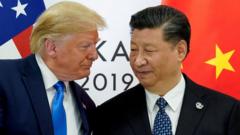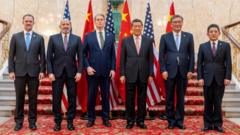The ongoing economic negotiations between the United States and China reveal a complex landscape following months of rising tensions.
**US-China Trade Negotiations: A Step Backward or Forward?**

**US-China Trade Negotiations: A Step Backward or Forward?**
A recent handshake agreement between the US and China raises questions about the effectiveness of past trade strategies.
After two days of intense discussions, American and Chinese officials have tentatively established a handshake agreement aimed at mitigating some of the damaging economic measures resulting from their ongoing trade discord. This tentative resolution, reached in the early hours of Wednesday in London, attempts to de-escalate the conflict that had worsened considerably in recent months.
However, uncertainties linger over whether this agreement will take hold — reminiscent of a prior truce established in May that soon collapsed. If this recent pact remains intact, it may only revert the economies of both nations back to a situation they were in a few months prior to the heightened tensions triggered by President Trump in early April, following his substantial tariff increases on Chinese imports.
"We seem to be negotiating in circles," commented Myron Brilliant, senior counselor at the DGA-Albright Stonebridge Group and former U.S. Chamber of Commerce executive vice president. He expressed frustration that “you escalate, you de-escalate, but at the end we are not really achieving substantial progress.”
The implications of this week's talks indicate that tariffs will generally remain unchanged, with limited details emerging beyond tentative rollbacks of recent aggressive policies from both sides. Notably, China is expected to ease restrictions on mineral exports, which had posed severe risks to various American manufacturing sectors. In exchange, the US is anticipated to relax restrictions on technology and product exports and may even roll back threats concerning visa cancellations for Chinese students in the United States.
As this complicated agreement unfolds, the world watches closely, wary of the implications for global trade stability.
However, uncertainties linger over whether this agreement will take hold — reminiscent of a prior truce established in May that soon collapsed. If this recent pact remains intact, it may only revert the economies of both nations back to a situation they were in a few months prior to the heightened tensions triggered by President Trump in early April, following his substantial tariff increases on Chinese imports.
"We seem to be negotiating in circles," commented Myron Brilliant, senior counselor at the DGA-Albright Stonebridge Group and former U.S. Chamber of Commerce executive vice president. He expressed frustration that “you escalate, you de-escalate, but at the end we are not really achieving substantial progress.”
The implications of this week's talks indicate that tariffs will generally remain unchanged, with limited details emerging beyond tentative rollbacks of recent aggressive policies from both sides. Notably, China is expected to ease restrictions on mineral exports, which had posed severe risks to various American manufacturing sectors. In exchange, the US is anticipated to relax restrictions on technology and product exports and may even roll back threats concerning visa cancellations for Chinese students in the United States.
As this complicated agreement unfolds, the world watches closely, wary of the implications for global trade stability.






















